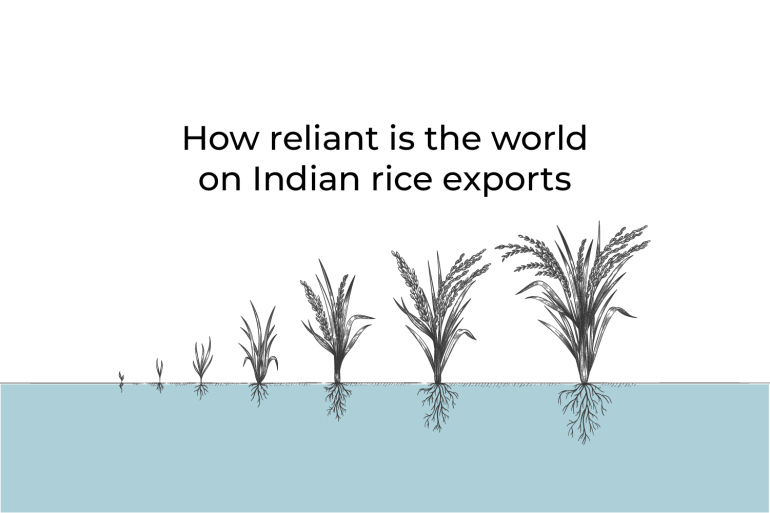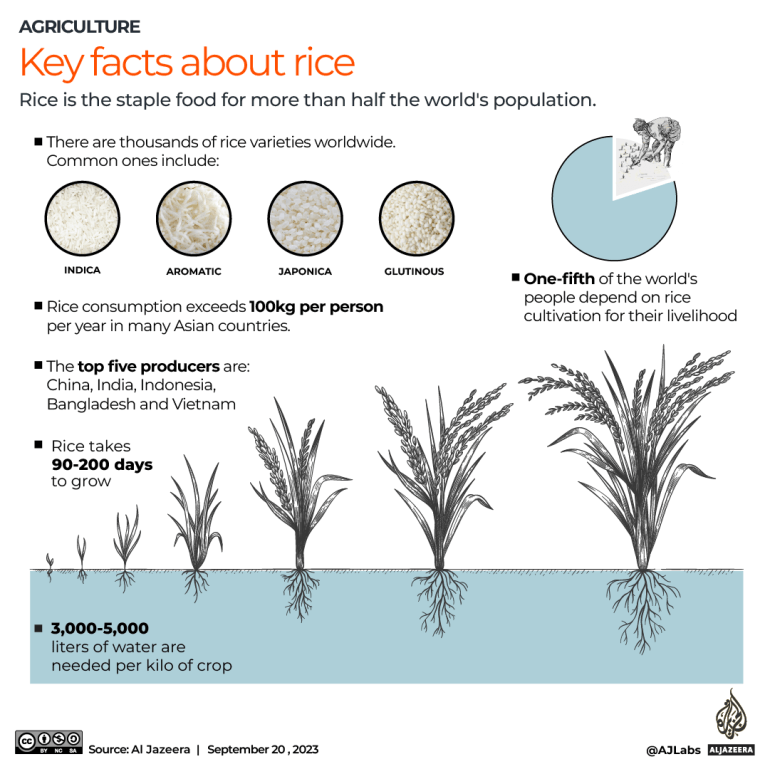How reliant is the world on Indian rice exports?
Rice is the most eaten food globally with half a billion metric tonnes consumed a year.

Global rice prices are at their highest levels in 15 years, according to the United Nations Food and Agriculture Organization (FAO).
The surge follows India’s announcement on July 20 that it would cease the export of non-basmati white rice with immediate effect. The decision came just days after Russia halted participation in the Black Sea Grain Initiative, causing global food commodity prices to rise.
Keep reading
list of 4 itemsMapping Israel-Lebanon cross-border attacks
Eid Mubarak: Hear greetings in different languages
When is Eid al-Fitr 2024 and how is it celebrated?
Traders have said a shortage of rice will have a knock-on effect on wheat, soya beans, corn and maize, which are used as rice substitutes.
In this infographic series, Al Jazeera visualises India’s rise to becoming the world’s largest exporter of rice and the nations that rely most on Indian rice exports.
How much water does rice use?
The practice of cultivating rice in paddies is believed to have originated about 8,000 BC along the Yangtze River in central China and then spread to India and other parts of Asia.
Rice is the third most-produced grain in the world after corn and wheat and typically takes 90 to 200 days to grow depending on the variety and environmental conditions.
There are thousands of rice varieties worldwide, each differing in terms of grain size, shape, colour, texture and cooking characteristics.
Rice is one of the most water-intensive crops to cultivate, typically requiring 3,000 to 5,000 litres of water per kilogramme of crop – about three times more water than wheat requires to grow.
India’s export ban was imposed to control domestic prices and as a precautionary measure against the warming El Nino weather pattern, which can cause droughts leading to lower yields or even crop failures.

India, the world’s largest rice exporter
Cheap domestic rice has made India the world’s largest rice exporter, accounting for nearly 40 percent of total rice exports, which is projected to reach 54 million tonnes over the 2022-2023 crop year.
India will export an estimated 20.5 million tonnes of milled rice this year, almost 2.5 times that of the second largest exporter, Thailand with 8.5 million tonnes. Thailand is followed by Vietnam (7.9 million tonnes), Pakistan (3.6 million tonnes) and the United States (2.1 million tonnes).
India has dominated rice exports over the past decade due in part to low local prices and high domestic stocks, which allows the country to offer rice at discounts.
The animation below shows the world’s top rice exporters from 2001 to 2023:
Who buys India’s rice?
From January to July, India exported about 12.9 million tonnes of rice worth nearly $7bn to at least 150 countries, according to India’s Directorate General of Commercial Intelligence and Statistics.
Three-quarters (77 percent) of India’s rice exports have been non-basmati parboiled rice while the remaining quarter (23 percent) has been basmati rice.
At 1.17 million tonnes, the West African country Benin has bought the most Indian non-basmati rice this year followed by Senegal (872,080 tonnes) and Kenya (685,302 tonnes).
Eight of the top 10 destinations for India’s rice are African nations that predominantly import broken rice, the cheapest and most filling variety.
India’s largest buyers of basmati rice this year were Saudi Arabia (639,150 tonnes), Iran (545,751 tonnes) and Iraq (383,687 tonnes).
The graphic below shows the top buyers of India’s non-basmati and basmati rice.
After India’s ban, the US Department of Agriculture (USDA) has lowered global rice trade forecasts for 2023 and 2024 with the organisation saying trade in the 2024 calendar year for milled rice is projected to be 52.9 million tonnes, down by 3.44 million tonnes from previous forecasts.
The ban has had a knock-on effect on the price of other rice varieties, and the high rice prices are unlikely to abate in the short term. The FAO has suggested that any likely recovery in rice trade by next year would require India’s export restrictions to be lifted.